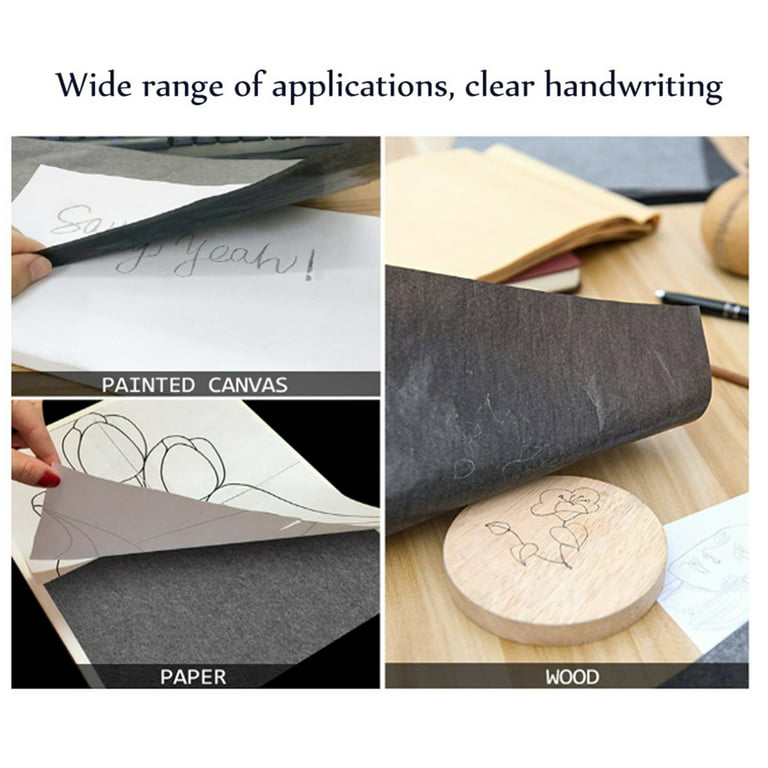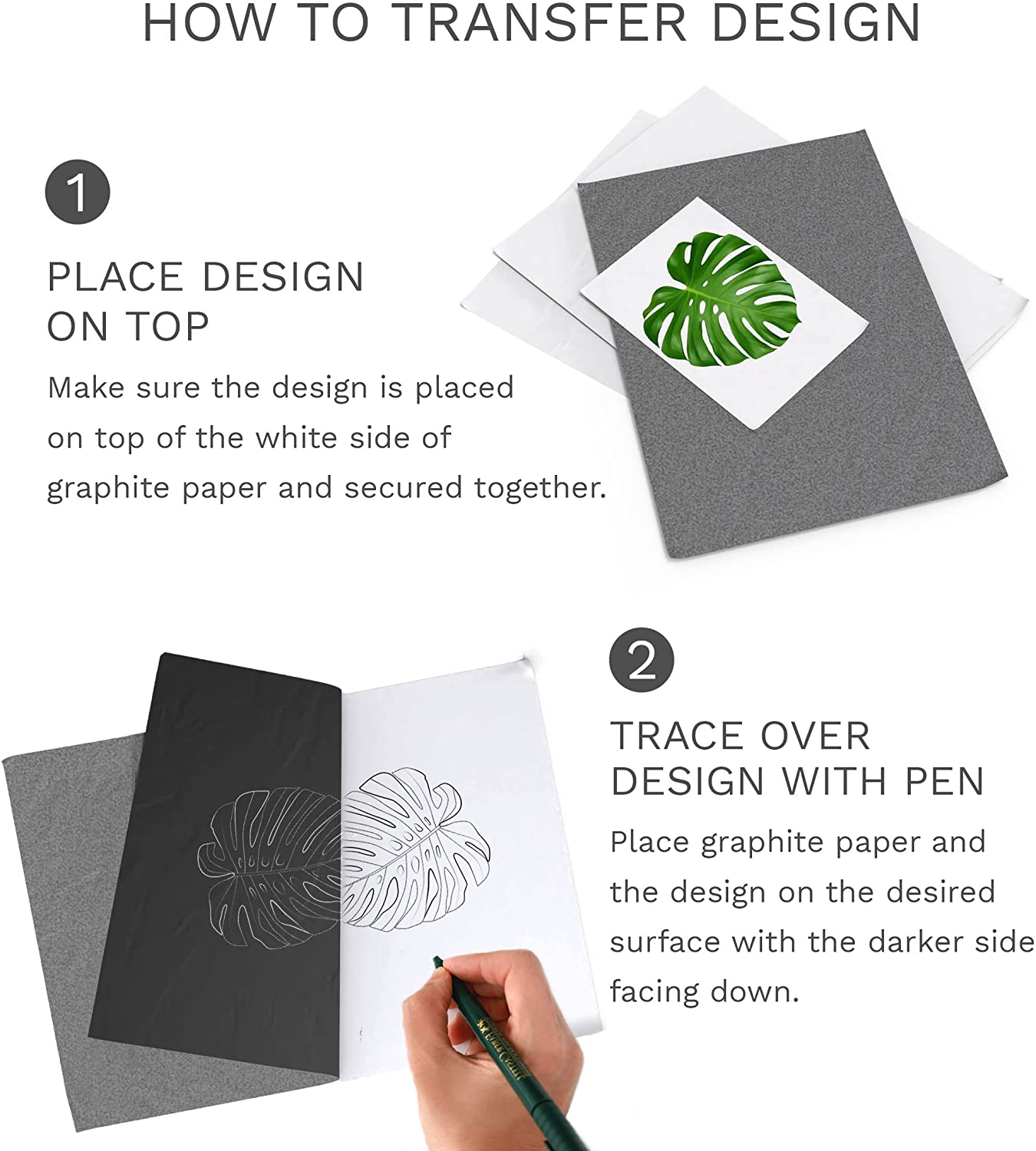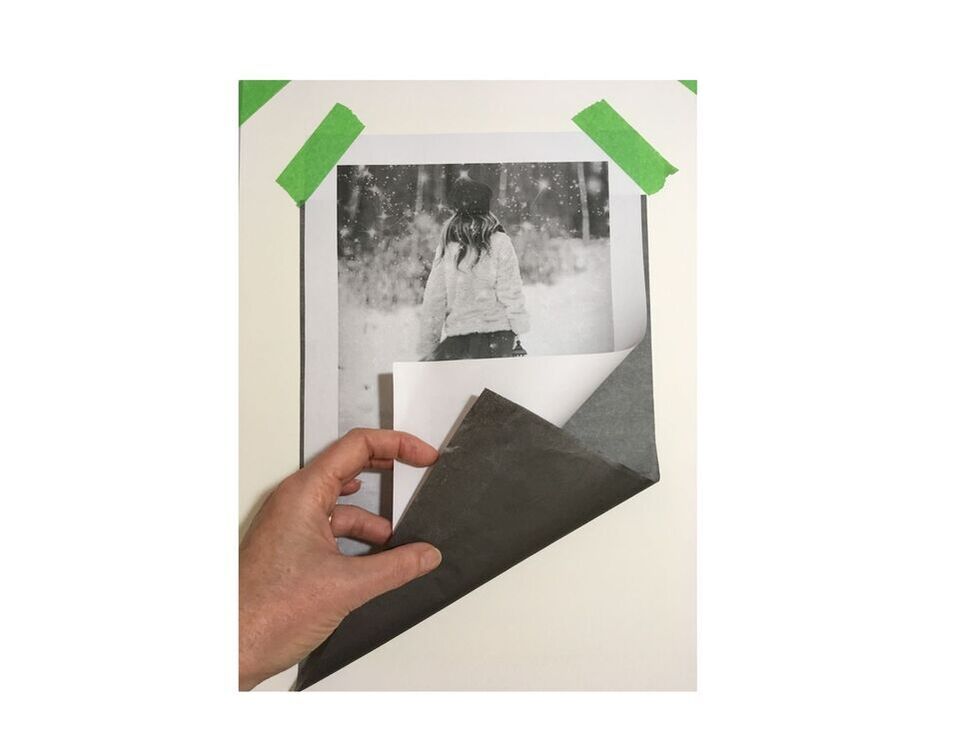What Are Graphite Tracing Paper Features?
What Are the Key Features of Graphite Tracing Paper?
Graphite tracing paper, commonly referred to as graphite transfer paper, is a crucial tool for artists and designers looking to replicate images with precision. This versatile medium boasts several key features that make it a popular choice amongst professionals and hobbyists alike.
Transferability of Graphite
One of the standout characteristics of graphite tracing paper is its ability to transfer images accurately. The transferability of graphite enables you to reproduce detailed pictures faithfully. You position the graphite side against your target surface, create your outlines with a stylus or pencil, and watch as the graphite effortlessly imprints your design. This method provides a clean finish and is especially useful for complicated artworks, ensuring that your original concept is captured just as you envision. For an excellent option, check out Saral Graphite Transfer Paper.
Thickness and Quality
The thickness and overall quality of graphite tracing paper directly influence its usability and the clarity of the transferred images. Thicker papers often provide a sturdier base, allowing for better handling without rips or tears. On the flip side, thinner papers can be advantageous for intricate designs since they create less bulk and are more flexible. It’s essential to choose the right thickness based on your project’s needs to achieve optimal image transfer. Consider exploring Loew-Cornell Graphite Paper for different thicknesses.
Compatibility with Surfaces
Graphite tracing paper can be used on various surfaces, which include canvas, fabric, wood, and ceramics. This compatibility is a significant advantage for artists who work across different mediums. For instance, when using graphite transfer paper on fabric, it allows you to create designs for clothing or tapestries with ease. When working on wood or ceramics, the transfer paper ensures that your designs adhere well, creating a solid foundation for further detailing.
Product Variations
Graphite tracing paper comes in diverse product variations, primarily categorized into waxless and waxed options. Waxless graphite paper is notable for its clean transfer and easy erasability, which makes it a favorite among artists. Conversely, waxed options can leave behind a richer, darker mark but may not erase as cleanly. Understanding the differences between these types is crucial for selecting the right paper for your needs.
| Typ | Vlastnosti | Ideální použití | Vymazatelnost |
|---|---|---|---|
| Waxless Options | Clean transfer, easy to erase | Precision drawings | Vysoká |
| Waxed Options | Richer impressions, heavier marks | Large projects | Mírná |
Environmental and User Safety Concerns
When choosing any art medium, safety is crucial. Luckily, many brands of graphite tracing paper are non-toxic and acid-free, making them safe for artists of all ages. This quality means that you can work without the fear of harmful chemicals impacting your health or damaging your materials over time. Environmental concerns are also less with these products, as being acid-free reduces the potential for long-term damage to your artwork.
Brands to Consider
Several reputable brands offer high-quality graphite tracing papers among the most popular are:
- Saral Graphite Transfer Paper: Known for its five color options (blue, yellow, graphite, white, and red), this waxless paper is non-toxic and acid-free, making it suitable for various surfaces.
- Loew-Cornell: Their black and white graphite transfer papers are ideal for non-porous surfaces and are smudge-proof and erasable.
- Royal & Langnickel: Their white graphite transfer paper comes in large sheets, perfect for broad projects without sacrificing detail. You can find their products at Royal & Langnickel Graphite Paper.
Choosing a brand will depend on the specific features you value most in graphite tracing paper.
Considerations for Beginners
For those just starting, using graphite tracing paper may seem daunting. However, understanding a few common pitfalls can greatly enhance your experience:
- Lens Distortion: Tracing directly from photos can cause distortion. It’s best to simplify images and focus on key elements, especially for intricate subjects like portraits or animals.
- Pressure Sensitivity: Apply even pressure with your stylus or pencil to avoid too dark or too light lines. Too much pressure can damage the paper and alter the final product.
- Alignment Issues: Ensure that your setup is secure, as misalignment can ruin your work. Use archival artist tape to keep everything in place while tracing.
Frequently Asked Questions
-
How is graphite tracing paper different from other tracing mediums? Graphite tracing paper allows for cleaner transfer and is erasable, giving you more control compared to traditional carbon transfer papers.
-
Are there specific safety precautions when using this paper? It's essential to work in a well-ventilated area and wash your hands after use to avoid graphite smudges.
-
Which brands offer the best quality graphite tracing papers? Brands like Saral, Loew-Cornell, and Royal & Langnickel are all known for their high-quality tracing paper.
By considering these features, you can make an informed choice on your graphite tracing paper, ensuring great results in your artistic projects!
How Do You Use Graphite Tracing Paper for Art and Design Projects?
Using graphite tracing paper can elevate your art and design projects. The process is simple and efficient. Below, I will guide you through essential steps to effectively utilize this versatile material.
Setting Up Your Workspace
Before diving in, it’s crucial to organize your workspace. Gather all materials: graphite tracing paper, your reference image, a clean sheet of the final artwork medium (like canvas or watercolor paper), and a pencil or stylus.
Tips for Organizing:
- Flat Surface: Ensure your workspace is level to prevent paper shifting.
- Tape: Use archival tape to secure the layers in place. This minimizes movement during tracing.
- Lighting: Good lighting helps you see details better, reducing errors during the transfer.
Secure the graphite paper so that the graphite side is facing down toward the artwork medium.
Tracing Techniques
To get the best results while tracing, employ the right tools and methods. A mechanical pencil is great for precise lines. It helps in capturing details that might be lost with a regular pencil.
Key Adjustments:
- Pressure Control: Apply even pressure to your tracing tool; too much can create dark lines or damage the paper.
- Start Light: Begin with gentle pressure. You can always darken the lines later if needed.
- Focus on Details: Pay special attention to important areas like features in portraits or focal points in landscapes for better accuracy.
Preventing Smudging
Graphite can be smudgy. Smudges can ruin your carefully traced image. Here are some best practices to keep your work clean:
- Wipe Hands: Regularly wash or wipe your hands to avoid transferring graphite.
- Handle with Care: After tracing, fold a clean sheet of paper over the traced area. This reduces direct contact.
- Glassine Paper: Consider wrapping your finished works in glassine, a smooth paper that protects while also allowing the piece to breathe.
Reusability and Longevity
A major advantage of graphite tracing paper is its reusability. Depending on the brand and usage, you can use it multiple times.
Maximizing Lifespan:
- Light Pressure: Lighter tracing prolongs the life of your graphite paper.
- Proper Storage: Store unused paper flat in a cool, dry place. Avoid folding it, as creases can degrade its effectiveness.
Regularly assess the condition of your tracing paper. If it seems too faint or worn, it may be time for a replacement.
Removing Graphite Residue
If you accidentally leave graphite marks on your final piece, don't panic; there are ways to clean up.
Cleaning Methods:
- Damp Cloth: Lightly dampen a cloth with water and gently wipe the residue.
- Erasers: A kneaded eraser can effectively lift excess graphite without smearing.
- Testing: Always test your cleaning method on a small, hidden area first.
Differences in Use Across Mediums
Graphite tracing paper works well with various surfaces, each with its own unique considerations.
| Střední | Recommendations | Úvahy |
|---|---|---|
| Watercolor Paper | Light pencil pressure while tracing | Transfers can blend with paint |
| Canvas | Use thicker tracing paper | Too much pressure can darken lines |
| Ceramics | Choose wax-free types | Prevents unwanted residue |
Řešení běžných problémů
Even experienced artists face issues when using graphite tracing paper. Here’s how to troubleshoot common problems:
- Smudging: If smudging occurs, use a clean, unmarked sheet to protect your artwork. Avoid placing your hand on freshly traced areas.
- Misalignment: If your layers shift, gently remove the graphite paper and realign it. Securing with tape will help prevent this.
- Over-Darkened Lines: Use a kneaded eraser to lighten excessively dark markings. Sometimes, a touch of water can help if you’re transferring onto watercolor paper.
Answers to Common Questions
-
How do I prevent graphite smudging during transfer? Wash hands regularly, use a light touch, and protect your work with glassine.
-
Can graphite paper be reused, and if so, how many times? Yes, it can be reused several times, often up to 10 uses depending on the quality and pressure applied.
-
What's the best way to clean up graphite residue from surfaces? Use a damp cloth or a kneaded eraser, testing on a hidden area first.
Graphite tracing paper opens up a world of possibilities for artists and makers. With careful use and attention to detail, your projects will shine!
How Does Graphite Tracing Paper Compare to Other Tracing Papers?
Graphite tracing paper is a popular choice among artists for its unique features and versatility. In this comparison, we’ll look at how graphite tracing paper stacks up against other tracing papers available in the market, focusing on various aspects that matter to artists.
Graphite vs. Carbon Transfer Paper: Comparing Visibility, Erasability, and Residue
When comparing graphite tracing paper to carbon transfer paper, visibility is a key factor. Graphite tracing paper offers a clear, dark mark that contrasts well on both light and dark surfaces. This visibility allows artists to make precise and detailed work.
Carbon transfer paper, while effective, can leave behind a heavier residue. This residue can be difficult to erase completely. In contrast, graphite tracing paper leaves a lighter mark that is easy to remove. Erasability is especially important for detailed work where adjustments are often needed, making graphite tracing paper a superior option.
| Typ papíru | Visibility | Vymazatelnost | Residue |
|---|---|---|---|
| Graphite Tracing | Vysoká | Easy to erase | Minimální |
| Carbon Transfer | Mírná | Difficult to erase | Heavy residue |
Waxless vs. Waxed Tracing Papers: Pros and Cons for Different Projects
The choice between waxless and waxed tracing papers can significantly influence your workflow. Waxless tracing papers, such as Saral or Loew-Cornell products, provide a clean, smudge-proof finish. They do not bleed through paint and are perfect for non-porous surfaces. These attributes make them ideal for intricate art pieces, as they maintain the integrity of the original work.
On the other hand, waxed tracing paper usually leaves a heavier mark. It can be easier to transfer designs because of its dark ink, but it also leaves a waxy residue that can be harder to erase. Therefore, it’s recommended to choose waxless papers for projects requiring precision, especially if you plan to layer with other mediums.
Popular Alternatives: Light Tables, DIY Options, and Pencil Transfer Methods
Artists often seek alternatives to tracing paper, and several methods come to mind. Light tables provide a straightforward option for transferring images by allowing you to see through layers. However, they require a dedicated workspace and may not be practical for all artists.
DIY options, such as using wax paper with graphite powder, can also be effective. The process is simple: apply graphite to the wax side and trace designs easily. While this option is cost-effective, it may not offer the same quality and reusability as store-bought graphite tracing paper.
Another method involves using a pencil on the back of a drawing. This technique is less efficient and may lead to uneven lines, though it is handy for quick transfers.
Situational Recommendations: Choosing the Right Type of Paper for Specific Projects
Selecting the right tracing paper for your project can significantly affect the outcome. For delicate watercolor projects, wax-free graphite paper is the best choice. It helps maintain a clean surface without smudging. Similarly, for canvas or fabric projects, wax-free options yield a crisp result.
If you're working with darker surfaces or requiring strong contrast, consider colored graphite tracing paper. Saral graphite paper, for example, offers varied colors like blue and yellow, allowing you to work effectively across a range of materials.
User Reviews and Testimonials: Insight from Artists on Preferences and Results
Many artists have shared their experiences with different tracing papers. A consistent favorite is Saral Graphite Transfer Paper. Artists rave about its erasability, ease of use, and ability to transfer intricate designs without permanent residue. A user noted, "It’s great for sketches! I can make adjustments and my sketches still look clean."
Others prefer the Loew-Cornell brand for its quality on various surfaces. Users appreciate its smooth application and ability to blend easily with other mediums. This testimonial highlights the effectiveness of graphite tracing paper, stating, "I use it for everything from wood projects to sketching on fabric. It never fails."
Price vs. Quality: Evaluating Costs Against Benefits and Performance
When it comes to tracing paper, balancing quality against price is crucial. Although some brands may be pricier, the benefits often justify the cost. High-quality graphite tracing paper like that from Saral or Loew-Cornell tends to last longer and provide better transfer quality, reducing the need for multiple sheets.
Consider that many graphite papers are reusable several times before losing effectiveness. This aspect enhances their cost-efficiency, especially for extensive projects. Investing slightly more in a reliable product can pay off in the long run through its durability and performance.
In conclusion, graphite tracing paper shines in various comparisons against other tracing types. Its visibility, erasability, and minimal residue make it a top choice for artists. When selecting a tracing medium, understanding the advantages and limitations of each paper type will enable you to make the best decision for your projects.
FAQs about Graphite Tracing Paper Features:
What is a key characteristic of graphite tracing paper?
Graphite tracing paper's standout feature is its ability to transfer images accurately, ensuring the original design is captured precisely.
How does the thickness of graphite tracing paper affect its use?
The thickness and quality of graphite tracing paper influence usability; thicker papers provide sturdiness, while thinner papers are flexible for intricate designs.
Can graphite tracing paper be used on different surfaces?
Graphite tracing paper is compatible with various surfaces, including canvas, fabric, wood, and ceramics, making it versatile for different artistic projects.
What are the differences between waxless and waxed graphite tracing papers?
Waxless graphite tracing papers offer clean transfers and easy erasing, while waxed options provide darker marks but may be harder to erase.
Are there any safety concerns with using graphite tracing paper?
Many graphite tracing papers are non-toxic and acid-free, making them safe for artists without the risk of harmful chemicals.
Graphite tracing paper stands out for its precise image transfer and versatility. From canvas to ceramics, it pairs well with many surfaces. Quality and safety matter, so choose non-toxic, acid-free options. Brands like Saral and Royal & Langnickel excel. Beginners, start simple and watch for smudges. Compare to carbon paper, graphite's erasability wins, and waxless variants shine for clarity. Choose wisely based on your art needs. Ready to create? Grab your graphite tracing paper and let your art flourish!





